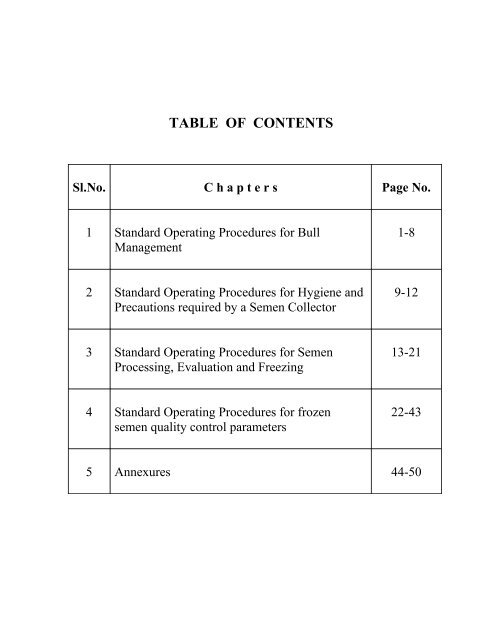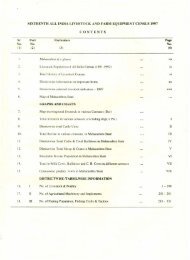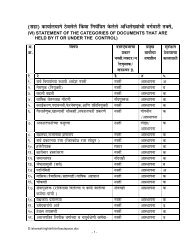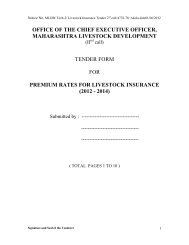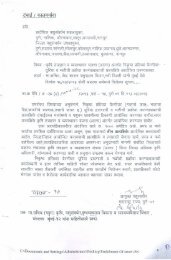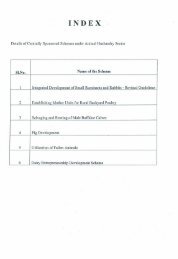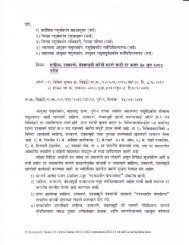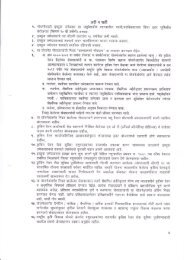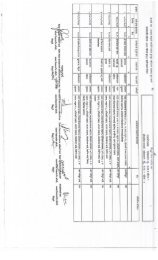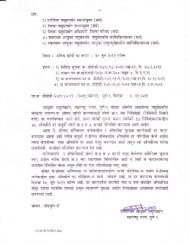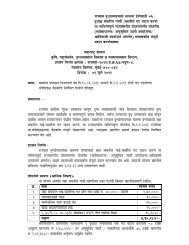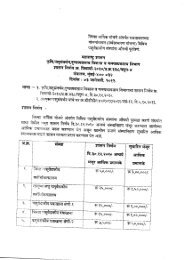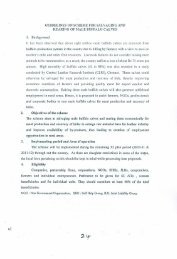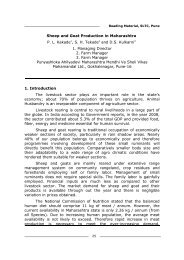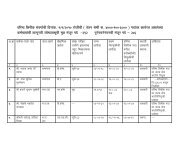Standard Operating Procedures for Bull Management (1088.47 KB)
Standard Operating Procedures for Bull Management (1088.47 KB)
Standard Operating Procedures for Bull Management (1088.47 KB)
Create successful ePaper yourself
Turn your PDF publications into a flip-book with our unique Google optimized e-Paper software.
TABLE OF CONTENTS<br />
Sl.No. C h a p t e r s Page No.<br />
1 <strong>Standard</strong> <strong>Operating</strong> <strong>Procedures</strong> <strong>for</strong> <strong>Bull</strong><br />
<strong>Management</strong><br />
2 <strong>Standard</strong> <strong>Operating</strong> <strong>Procedures</strong> <strong>for</strong> Hygiene and<br />
Precautions required by a Semen Collector<br />
3 <strong>Standard</strong> <strong>Operating</strong> <strong>Procedures</strong> <strong>for</strong> Semen<br />
Processing, Evaluation and Freezing<br />
4 <strong>Standard</strong> <strong>Operating</strong> <strong>Procedures</strong> <strong>for</strong> frozen<br />
semen quality control parameters<br />
1-8<br />
9-12<br />
13-21<br />
22-43<br />
5 Annexures 44-50
Chapter – 1<br />
<strong>Standard</strong> operating <strong>Procedures</strong> <strong>for</strong> bull <strong>Management</strong>
<strong>Standard</strong> <strong>Operating</strong> <strong>Procedures</strong> <strong>for</strong> <strong>Bull</strong> <strong>Management</strong><br />
The <strong>Standard</strong> <strong>Operating</strong> <strong>Procedures</strong> (SOP) provides general guidelines <strong>for</strong> all the<br />
activities that are taking place in a Frozen Semen Station (FSS). All the guidelines may not<br />
be appropriate in all the situations / conditions. The respective FSS has to prepare a few<br />
more guidelines supplementing the SOP.<br />
<strong>Bull</strong> <strong>Management</strong>:<br />
Introduction<br />
Breeding bulls selected by Frozen Semen Station (FSS) are considered highly valuable<br />
units of semen production. Good management practices are essential <strong>for</strong> maximizing use of<br />
the selected bull. The breeding bull is expected to produce large number of frozen semen<br />
doses (FSD) of good quality which will result in optimum pregnancy rate in the field. The<br />
number of doses produced per bull per year depends on breed, size and age of the bull.<br />
<strong>Bull</strong> management comprises of following:<br />
1. Supply of adequate fodder and feed.<br />
2. Supply of potable water at all the time.<br />
3. Housing and floor<br />
4. Exercise of bulls<br />
5. Vaccination, screening and measures <strong>for</strong> health care<br />
1. Supply of adequate fodder and feed.<br />
The management of fodder and feed <strong>for</strong> breeding bulls is not as complicated as that of<br />
dairy cattle. The requirements <strong>for</strong> maintenance if met are adequate. However the<br />
regularity and consistency in the quality is an important factor.<br />
a. Supply of fodder<br />
The bulls being ruminants require fodder of good quality and in adequate quantity <strong>for</strong> their<br />
maintenance. It is estimated that a developing bull requires 2.5 – 3.0 % of body weight as<br />
dry matter per day and 1.0-1.2% crude protein with 65% TDN. Yearling bull need dry<br />
matter 2.0 to3.0% of the body weight per day whereas adult bull dry matter intake is 1.2<br />
to1.4% of body weight per day. This includes concentrate i.e. compounded cattle feed. A<br />
table showing requirements of nutrients may be referred <strong>for</strong> providing fodder and feed.<br />
The quality of fodder of any crop varies considerably according to age of the<br />
crop, soil conditions and irrigation etc. Hence it is recommended that each FSS should<br />
arrange proximate analysis of different fodder crops cultivated in order to determine the<br />
nutrient quality and optimum time of harvest of fodder.
Feeding Growing and Mature <strong>Bull</strong>s<br />
Daily nutrient requirements of growing and mature bulls *<br />
Body wt<br />
(Kg.)<br />
gain/day<br />
(g)<br />
DM/day<br />
(Kg.)<br />
C.P. (g) TDN (kg) Ca (g) P (g)<br />
Vit. A<br />
(1000 IU)<br />
Growing bulls<br />
100 750 2.8 390 1.9 11 8 4<br />
150 750 4.3 460 2.7 15 11 6<br />
200 750 5.7 530 3.4 18 14 8<br />
250 750 7.0 610 4.0 21 16 10<br />
300 750 8.2 680 4.6 23 17 13<br />
350 750 9.3 760 5.2 24 18 15<br />
400 700 10.2 820 5.7 25 19 17<br />
450 600 10.4 875 5.8 26 20 19<br />
500 400 10.0 885 5.6 26 20 21<br />
550 250 10.0 845 5.6 25 19 23<br />
600 100 9.8 800 5.5 24 18 26<br />
Maintenance of mature breeding bulls<br />
500 - 8.3 640 4.6 20 15 21<br />
600 - 9.6 735 5.4 22 17 26<br />
700 - 10.9 830 6.1 25 19 30<br />
Daily ration <strong>for</strong> <strong>Bull</strong>s<br />
Body wt.<br />
(Kg.)<br />
Calf starter (Kg.)<br />
C.F.<br />
(Kg.)<br />
B.P.F.<br />
(Kg.)<br />
Hay<br />
(Kg.)<br />
Green Fodder<br />
(Kg.)<br />
Growing bulls<br />
100 2 - - 0.5 6-8<br />
150 - - 2 0 8-10<br />
200 - - 2 0.5 15<br />
300 - 2 1 ad lib.<br />
400 a) - 2 3 ad lib.<br />
b) - 2.5 - 3 ad lib.<br />
500 a) - - 2.5 2-4 ad lib.<br />
b) - 3 - 2-4 ad lib.<br />
600 a) - - 2.5 2-4 ad lib.<br />
b) - 3 - 2-4 ad lib.<br />
Mature breeding bulls<br />
500 a) - 2.5 - 2-4 ad lib.<br />
b) - - 2 2-4 ad lib.<br />
600 -------------------------------do------------------------<br />
700 -------------------------------do------------------------
Except <strong>for</strong> very tender and succulent fodders like Lucerne / Berseem, all other<br />
fodders should be chaffed be<strong>for</strong>e feeding. The blades of the chaff cutter should be<br />
adjusted in such a manner to ensure the size of the cut fodder is at least 50 mm. Too<br />
small size of fodder is not recommended. The dry fodder i.e. hays / Stover should be<br />
chaffed preferably along with green fodder. The dry fodder can also be fed<br />
separately.<br />
Feeding of good quality hay is recommended instead of feeding paddy straw / maize<br />
or Ragi straw. The hay is more nutritious and palatable. Wherever it is possible to<br />
feed large quantity of hay, the green fodder can be reduced to 5 – 10 kg / bull / day.<br />
The sorghum hay, oat hay and Lucerne hay are most recommended <strong>for</strong> bulls. As a<br />
result of feeding good quality hay in larger quantities, the bulls will be more clean<br />
and hygienic.<br />
Feeding of silage under tropical conditions has shown varying results. Feeding of<br />
maize / oat silage in limited quantity of 10 – 15 Kg. / day / bull is harmless.<br />
Wherever silage is prepared, adequate precautions should be taken to avoid growth of<br />
moulds and aerobic condition.<br />
b. Concentrate Feeding<br />
In order to balance the nutrient requirements, it is essential to include limited quantity<br />
of cattle feed. The feed should be produced using good quality ingredients free from<br />
toxic elements and moulds and fungi. The FSS should arrange <strong>for</strong> proximate analysis<br />
of the feed at regular intervals to ensure the nutrient quality of the feed. The feed<br />
should be purchased from a reputed manufacturer or should be prepared in house.<br />
The feed can be in the <strong>for</strong>m of mash or pellets. It is preferable to avoid feeding of<br />
cotton seed cake to bulls.<br />
The feed should be supplied to bulls mixed with small quantity of green / dry fodder<br />
to stimulate salivary glands.<br />
c. Feeding of Mineral mixture<br />
Supplementary feeding of 30 – 80 g. of mineral mixture / day / bull is essential to<br />
meet the physiological requirements. The quantity varies upon the body weight of the<br />
bull and mineral profile of the soil used <strong>for</strong> fodder cultivation. If data on mineral<br />
profile of the district is available, it should be used <strong>for</strong> <strong>for</strong>mulating appropriate<br />
mineral mixture. The ingredients of the mineral mixture should be free from animal<br />
origin. The mineral mixture without salt should be preferably purchased. Salt in the<br />
range of 10 – 15 g / day / bull can be added to the mineral mixture. The mineral<br />
mixture should be thoroughly mixed with concentrate feed to avoid wastage.
2. Supply of potable water at all the time.<br />
a. Water is one of the most important component of nutrients and it should be made<br />
available all the time. The water should be clean, free from organic matter and<br />
potable. The water should be under shade and accessible all the time.<br />
b. Fresh water should be available all the time.<br />
c. River water / pond water should be used after adequate treatment to eliminate<br />
contaminants and biological material.<br />
3. Housing and floor.<br />
Each FSS should have permanent housing arrangements <strong>for</strong> mature breeding bulls along<br />
with facility <strong>for</strong> isolation shed <strong>for</strong> about 4 – 5 bulls. The isolation shed should be about<br />
500 mts. from the main housing of bulls. In addition each FSS should also have facility<br />
<strong>for</strong> quarantine of new bulls, which are to be inducted into FSS. This facility should be at<br />
least Five kilometer away from main housing. All housing facilities should have<br />
arrangements <strong>for</strong> feeding and supply of water.<br />
a. Housing and temperature control<br />
The bulls have to live 24 Hours and 365 days in the housing provided. The type of<br />
housing decides the com<strong>for</strong>t level and quality and quantity of semen production.<br />
The sheds should be in East – West direction to avoid direct sunlight on bulls. There<br />
are reports of testicular degeneration due to intense sunlight on testis / scrotum. In<br />
case the sheds are already in north – South direction, measures should be taken to<br />
provide shade to bulls to protect from direct sunlight. The sheds should be airy and<br />
allow breeze. Trees to protect from hot air during summer should surround the sheds.<br />
There should be top ventilation to allow escape of hot air. In the states where the<br />
climate is hot most of the part of the year, the sheds should have minimum walls and<br />
steel pipe railing should be used <strong>for</strong> better ventilation. There should be provision of<br />
water foggers and fans <strong>for</strong> use during the summer particularly <strong>for</strong> exotic breeds and<br />
buffalo bulls. The fans and water foggers should be operated alternately <strong>for</strong> about 4 –<br />
5 hours / day during summer time. During summer, it is desirable to wash the buffalo<br />
bulls twice a day. The exotic and crossbred bulls can be washed with water on<br />
alternate days to keep them clean. It is recommended to groom the cattle bulls with<br />
coir / nylon brush every day to keep the skin in shining and glowing condition.<br />
Single bullpens having loafing area are suitable and ideal <strong>for</strong> breeding bulls. The bulls<br />
should be kept free. The bullpens should have feeding manger and water trough. Each<br />
bull should have adequate covered area (minimum 10 M 2 ).<br />
In places where the climate is very cool most of the year, the walls are recommended.<br />
However attention should be given to ensure adequate ventilation and avoiding stale<br />
air in the sheds.
In places where the individual bull housing is not practiced, adequate bedding should<br />
be provided.<br />
b. Flooring<br />
Each bull should have adequate loafing area (minimum 10 M 2 ). The flooring of<br />
covered area should be non-slippery cement concrete with adequate grooves. The<br />
flooring of the loafing area should be preferably with natural soil. In case of heavy<br />
rainfall areas, the flooring can have sub soil drainage system to avoid slush. To avoid<br />
excessive slush in monsoon, there should be drain to take away rainwater from roof.<br />
The housing should be designed in such a manner so that the personnel working are<br />
safe. If possible the loafing area and covered area should be separated with a gate so<br />
that persons can clean. The floors should be scrubbed and burnt at least once in a year<br />
by blowlamp.<br />
4. Exercise of bulls.<br />
As per the published literature, the effect of exercise of bulls on the semen quality is<br />
varying. However it is preferable to exercise the bulls at least on alternate days <strong>for</strong> about<br />
45 minutes to one hour. During the exercise, it would be possible to observe the gait and<br />
note any lameness / foot problems.<br />
5. Vaccination, screening and measures <strong>for</strong> health care.<br />
Considering the physiology of spermatogenesis, it is preferable to avoid any type of<br />
vaccination as vaccination induces febrile reaction and thereby quality of semen.<br />
However keeping in view the prevailing animal disease outbreaks, it is recommended to<br />
plan a vaccination schedule and implement strictly. Wherever possible it is recommended<br />
to minimize the number of vaccinations each year using combination vaccines like HS &<br />
BQ. In case of FMD, it is preferable to use oil adjuvant vaccine.<br />
It is recommended to wash the site of vaccination with 2% Savlon / Dettol solution prior<br />
to vaccination to avoid <strong>for</strong>mation of abscess due to secondary infections. The spot of<br />
injections should also be cleaned with surgical spirit / tincture of iodine. One should<br />
ensure use of correct vaccine and correct dose and route. The instructions of manufacturer<br />
should be followed and the in<strong>for</strong>mation, batch number, date of expiry of vaccine should<br />
be recorded at the time of vaccination.<br />
It is preferable to arrange <strong>for</strong> vaccination of cloven-footed animals in 3 – 5 Km. radius of<br />
FSS. This will help in control of outbreaks in FSS and minimize losses. By this method,<br />
it will be possible to establish a ring of immunity.
The breeding bulls should be screened <strong>for</strong> Brucellosis, TB, JD, Campylobacter and<br />
Trichomoniasis. The Government of India has mandated the Regional Disease Diagnostic<br />
Laboratories (RDDL) <strong>for</strong> screening the breeding bulls in the Frozen Semen Stations. The<br />
officer In charge of FSS should establish contact with the respective RDDL <strong>for</strong> deciding<br />
schedule of screening. Proper documentation of the screening should be maintained.<br />
Each FSS should have a tyre wash which should be filled with 4% solution of washing<br />
soda (Sodium Carbonate). The size of tyre wash should be at least 8.5 Mts. long 3.5 mts.<br />
wide and 20 cms deep to ensure dipping of rear tyre of tractor. This is required to avoid<br />
entry of viral diseases into cattle sheds. At the place of entry to FSS, a footbath and hand<br />
wash should also be provided. The footbath as well as hand wash should have 4% soda<br />
solution. Provision <strong>for</strong> washing of hands after dipping in the soda solution should be<br />
made. All the staff as well as visitors to FSS should use foot bath as well as hand wash<br />
be<strong>for</strong>e entering. The bull sheds as well as pathways should be sprayed with 4% soda<br />
solution at weekly intervals to reduce chances of viral diseases.<br />
If ecto parasites are common, measures should be taken to reduce by use of safe sprays<br />
like Butox etc. If tick infestation is high, the exotic and crossbred bulls should be<br />
vaccinated against Theilerosis once in three years. (Check the recommendation of<br />
manufacturer).<br />
In case of buffalo bulls, shaving of the over grown hair at periodical intervals has to be<br />
arranged.<br />
The hooves of the bulls have to be trimmed at periodical intervals to prevent over growth<br />
and lameness. Particularly bulls of exotic breeds like H.F. are more prone <strong>for</strong> hoof<br />
problems. Wherever pure H.F bulls are maintained, it is recommended to arrange a<br />
separate footbath <strong>for</strong> bulls. The bulls should be made to stand in the footbath <strong>for</strong> at least<br />
half an hour at weekly intervals. The footbath should be filled with 0.5% copper sulphate<br />
solution. Alternately 1% <strong>for</strong>malin solution can also be used either <strong>for</strong> footbath or spray on<br />
the hooves.<br />
Strong smelling disinfectants like phenyl or <strong>for</strong>malin should not be used in bull shed<br />
instead compound like gluteraldehyde, colloidal iodine or chlorine compounds like hypo<br />
chlorate be used.
Preparation of bulls <strong>for</strong> collection:<br />
Each FSS should have the semen collection roster and it should be accessible to the staff<br />
working in the bull sheds. The preparation of the bulls scheduled <strong>for</strong> collection should begin<br />
on previous day collection.<br />
The prepucial hair should be trimmed to 2-cm. lengths. Long prepucial hair causes adhering<br />
of the dung leading to spoiling the ejaculate. If trimmed too closely, it will cause irritation<br />
leading to frequent masturbation / infection of prepuce.<br />
The under side of abdomen should be washed on the day of collection to ensure freedom<br />
from dung etc. The prepuce should be cleaned with 0.9% normal saline solution and wiped<br />
dry using a disposable paper napkin/sterile towel.<br />
All the bull attendants should wear uni<strong>for</strong>m of same color. The bull attendants who work<br />
closely with bulls i.e. grooming, semen collection etc. should wear protective foot wear to<br />
avoid injuries.
Chapter – 2<br />
Hygiene and Precautions required by a Semen collector
Hygiene and Precautions required by a Semen collector<br />
Hygiene of collector<br />
a. Be<strong>for</strong>e entering the collection arena change civil dress and footwear in the<br />
anteroom.<br />
b. Wear protective semen collection clothing (pilot suit and cap) and gumboots.<br />
Greenish coloured overalls are preferred.<br />
c. Be<strong>for</strong>e every collection, wash hands with 0.1 % savlon or use disposable gloves<br />
or do both.<br />
d. Use a new pair of disposable gloves <strong>for</strong> each collection. If not, wash and disinfect<br />
hands after each semen collection.<br />
e. Use a sterilized napkin to wipe hands and change napkin after each collection.<br />
f. Collector should not enter the AV room during collection.<br />
g. Wash the footwear and coat daily immediately after completion of semen<br />
collection work.<br />
h. The semen collector should not enter the semen laboratory<br />
Precautions to be taken by Semen Collector:<br />
1. Collection arena<br />
a. Collection area should have at least 3 to 4 semen collection crates so that the<br />
mounting bull will get sufficient choice of stimulus animal. The arena should<br />
provide good footing <strong>for</strong> the bull and the teaser.<br />
b. Ensure that there are no slippery surfaces in the collection area.<br />
2. Collect semen from only a clean and groomed bull<br />
a. Check the coat and underline of the bull to be collected <strong>for</strong> any dung or dirt<br />
b. If soiled, clean carefully with soap or mild detergent long be<strong>for</strong>e collection.<br />
c. Rinse then with clean water and dry with clean towel.<br />
d. Towel used on one animal should not be reused on another.<br />
e. Ensure that animal is dry at collection.<br />
f. The preputial hair of the bull to be collected should be short (2 cm) and<br />
hooves trimmed.
3. Provide adequate sexual preparation <strong>for</strong> the bull<br />
a. Adequate sexual preparation eliminates the need <strong>for</strong> intensive collection.<br />
b. Select appropriately sized stimulus animal and present it in an area af<strong>for</strong>ding<br />
the bull good footing.<br />
c. The bull’s nose is tender. There<strong>for</strong>e the lead rope should not be jerked<br />
violently.<br />
d. Novel stimulus elicits sexual response in bulls and hence the collector should<br />
attempt novelty through the following approaches:<br />
1) Presentation of the same stimulus animal in a new location,<br />
2) Presentation of a new stimulus animal or<br />
3) Combination of animals in the original location or presentation of new<br />
stimulus animals in a new location.<br />
e. <strong>Bull</strong> should be allowed at least two false mounts with two minutes restraint<br />
be<strong>for</strong>e taking collection.<br />
1) During the false mount the bull should be encouraged to mount directly<br />
from the rear.<br />
2) The semen collector should ensure that whenever a bull mounts every<br />
ef<strong>for</strong>t must be made to assure that the mount animal does not move.<br />
f. Use of bull aprons during false mount will avoid the penis touching<br />
hindquarter of the stimulus animal.<br />
g. Tie the bull aprons just be<strong>for</strong>e starting the false mount .Use separate bull<br />
aprons <strong>for</strong> each ejaculation and each bull.<br />
4. Collection of semen<br />
a. Semen should be obtained from an animal with normal libido.<br />
b. Collection should be attempted only if the bull is properly sexually prepared.<br />
c. Check temperature of the artificial vagina be<strong>for</strong>e collection. Ideal temperature<br />
is 45ºC <strong>for</strong> adult bulls and between 42-45ºC <strong>for</strong> young bulls. (Pressure- 45 to<br />
55 mm of Hg. Younger bulls requires higher pressure.)<br />
d. After the penis has completely separated from the sheath serve the AV. The<br />
collector should not touch the penis of the bull, the touching of the penis by<br />
the collector causes shying of the bull and the bull will not readily mount<br />
e. Ensure that there is an interval of minimum 10-15 minutes between two<br />
collections of the same animal.<br />
f. Be certain that the proper sized artificial vagina is used. Use 30 cm AV <strong>for</strong><br />
adult bull and 25cm Av <strong>for</strong> adult buffalo bull
g. Hold the AV be<strong>for</strong>e and after each semen collection in such a way that the<br />
lubricating jelly/ debris after collection is not mixed with the ejaculate.<br />
h. The collection tube should be kept warm at 35°C be<strong>for</strong>e collection. It should<br />
be covered with felt cap, or warm water jacket<br />
i. The whole cone and collection tube should be covered with insulation bag.<br />
The window of the insulation bag should be always kept on dorsal side.<br />
j. Protect the semen collection tube from sunlight.<br />
k. Never use chipped or defective collection tube.<br />
l. Separate AV should be used <strong>for</strong> each bull and <strong>for</strong> each ejaculate and even if<br />
the bull inserts the penis in the AV without ejaculation the AV should be<br />
changed<br />
m. To reduce possible loss of sperm do not remove the artificial vagina from the<br />
penis too quickly after the bull has ejaculated. (especially in buffalo)<br />
n. Avoid contamination of semen by water, lubricating jelly or other harmful<br />
substances.<br />
o. Be certain to identify semen collection tube with the correct bull number.<br />
p. Report any abnormal events to laboratory personnel (<strong>for</strong> example: bloody<br />
semen, leak in inner liner, loss of ejaculate).<br />
q. Immediately after collection dip the AV’s in a container having neutral<br />
detergent solution <strong>for</strong> cleaning.<br />
r. Teamwork between bull handler and semen collector is essential to assure<br />
correct bull identification, use of correct sexual preparation procedure and<br />
safety of employees.<br />
s. At the time of collection both the collector and herdsman should avoid sudden<br />
moves.<br />
t. Avoid distractions during semen collection. The entry of visitors shall be<br />
prohibited.<br />
5. <strong>Management</strong> of <strong>Bull</strong>s during collection<br />
a. The semen collector should understand the individual bull’s sexual behavior<br />
and physiology.<br />
b. The semen collector and bull attendants should not be changed frequently.<br />
c. Never mistreat or abuse a bull at the time of semen collection. Too high<br />
temperature of AV, <strong>for</strong>cing of the AV on penis, grasping of the penis instead<br />
of sheath are painful conditions leading to sexual suppression.
Chapter - 3<br />
<strong>Standard</strong> <strong>Operating</strong> <strong>Procedures</strong> (SOP) <strong>for</strong> Semen processing,<br />
Evaluation and Freezing.
.<br />
<strong>Standard</strong> <strong>Operating</strong> <strong>Procedures</strong> (SOP) <strong>for</strong> Semen processing,<br />
Buffer preparation<br />
Evaluation and Freezing.<br />
a. Is to be done in a separate buffer / dilutor preparation room which has been<br />
sterilized regularly by <strong>for</strong>malin/commercially available disinfectant<br />
humidification as per MSP<br />
b. All chemicals used <strong>for</strong> buffer preparation namely:<br />
1. Tris (hydroxy methyl amino methane)<br />
2. Citric acid monohydrate<br />
3. D-Fructose<br />
Should be procured from reputed manufacturers and should be either of<br />
Analytical Grade (AR) or Graded Reagent (GR).<br />
c. Laboratory Grade (LR) of chemicals should not be used due to low purity.<br />
d. Chemicals should be weighed by an analytical electronic balance <strong>for</strong> high<br />
accuracy in order to arrive at the desired pH and osmolarity.<br />
e. Preferably Ultra-pure water (of 16- 18 mega ohms) should be used <strong>for</strong> preparation<br />
of the buffer.<br />
f. Alternatively freshly prepared distilled and autoclaved water shall be used.<br />
g. The buffer should be prepared by a competent person of the laboratory (lab<br />
technician / lab assistant)<br />
h. All receptacles used should have been sterilized.<br />
i. The lab technician should have a change of clothing (apron, cap and mask) and<br />
wear laboratory foot ware prior to entry into the dilutor preparation room.<br />
j. The hands of the technician and the worktable / laminar airflow unit (LAFU)<br />
should be sterilized by use of 70% alcohol.<br />
k. Preferably the technician may wear surgical disposable gloves.<br />
l. The buffer preparation should be done under a LAFU.<br />
m. The composition of the buffer is as follows<br />
1. Tris - 24.20 grams<br />
2. Citric acid - 13.80 grams<br />
3. Fructose - 10.00 grams<br />
n. Ultra pure water / autoclaved distilled water – 730 ml is added and the same is<br />
mixed well.<br />
o. The buffer is then autoclaved at 5 pounds pressure <strong>for</strong> a period of 10 minutes.<br />
p. After cooling the pH of buffer is taken by use of a pH meter which has been<br />
standardized and has been put on at least 20 minutes prior to estimation of pH.<br />
q. The pH of buffer should be between 6.7 and 6.9.<br />
r. When ever chemicals of a new batch / company are introduced care should be<br />
taken to test its quality prior to use.(by splitting the sample-check freezability)
Dilutor preparation<br />
a. The autoclaved buffer is cooled. If not used immediately it should be stored in a<br />
refrigerator at 4 to 8 degree Celsius.<br />
b. The dilutor can be prepared fresh on the day of collection early in the morning or<br />
on the previous day in the evening.<br />
c. If prepared on the previous day it may be noted that antibiotics should be added<br />
only in the morning prior to use.<br />
d. All hygienic measure as mentioned in the buffer preparation should also be<br />
employed during dilutor preparation by the lab technician and should be carried<br />
out under a LAFU.<br />
e. 200 ml of egg yolk is taken in a one liter graduated measuring cylinder<br />
f. The buffer prepared the previous day is added, and to this 70 ml of Glycerol (AR<br />
grade from a reputed company) is added.<br />
g. Glycerol can be warmed at 60°C temperature after measuring to increase its<br />
miscibility or added to the buffer itself prior to sterilization/autoclaving the<br />
previous day.<br />
h. Eggs used <strong>for</strong> preparation of dilutor should be fresh and purchased from a known<br />
source to avoid Mycoplasma / Salmonella infections.<br />
i. The eggs should be stored in a refrigerator after wiping with dry cotton not more<br />
than 2-3 days.<br />
j. Just prior to dilutor preparation eggs shall be wiped with 70% alcohol.<br />
k. Egg yolk shall be separated from albumin using an egg separator onto autoclaved<br />
filter paper (What man filter paper. No- 1 or filter paper of equivalent quality) and<br />
rolled over to remove the entire albumin be<strong>for</strong>e adding to the buffer.<br />
l. A mixture of antibiotics is added with a bactericidal activity to the dilutor:<br />
Benzyl penicillin 500/1000 IU/ml and dihydro streptomycin 1 micro gm/ml or<br />
Lincomycin-spectinomycin 150/300 micro gram/ml, Gentamicin 250 micro<br />
gram/ml ,Tylosin 50 micro gram /ml<br />
m. pH of the final diluent’s should be taken daily and recorded<br />
n. The glass stopper is put on the measuring cylinder and diluents mixed gently and<br />
transferred to a conical flask.<br />
o. A sterilized magnet is put into the conical flask, covered by aluminum foil and<br />
then placed on a magnetic stirrer <strong>for</strong> a period of 30 minutes <strong>for</strong><br />
homogenization.(Surgical Spirit to be used <strong>for</strong> sterilizing the magnet).<br />
p. The work area should again be sterilized by use of 70% alcohol.<br />
Extension and Evaluation of semen<br />
a. Is done in the processing room which has been well fumigated with <strong>for</strong>malin<br />
regularly and aerated prior to commencement of work.<br />
b. Only authorized personnel shall be allowed access into the processing room.<br />
c. The room temperature shall be maintained at 20 degree Celsius by use of split air<br />
conditioners.
d. No staff from the semen collection group / AV preparation room and visitors shall<br />
be allowed in the processing room.<br />
e. All staff working in the processing room should wear laboratory apron, mask, cap<br />
and disposable rubber gloves in the laboratory.<br />
f. Reusable clothing materials should be washed, cleaned and sterilized on a daily<br />
basis.<br />
g. The work tables / surfaces / LAFU and hands of operator should be sterilized by<br />
use of 70% alcohol prior to commencement of work.<br />
h. The semen in a collection tube capped with aluminum foil, suitably identified by<br />
the collection team is placed in a constant temperature water bath of 34 degree<br />
Celsius in the pass box.<br />
i. As soon as the semen is received it is observed <strong>for</strong> color, and presence of visible<br />
contaminants like dung, dust, blood, pus etc..<br />
j. The volume of semen along with the breed and bull number is recorded.<br />
k. The sperm concentration is assessed in a bovine photometer which has been<br />
standardized and validated regularly at least once in six months by<br />
hemocytometer readings.<br />
l. A fresh cuvette is used <strong>for</strong> each sample / ejaculate.<br />
m. Sampling tube should also be changed in the dilutor unit <strong>for</strong> each ejaculate and<br />
never reused.<br />
n. Initial dilution of semen with diluent’s maintained at 34 degree Celsius in a<br />
thermo controlled water bath is done <strong>for</strong> all samples showing concentration of<br />
greater than 500 million / ml<br />
o. Semen samples with concentration below 500 million per ml are discarded<br />
p. First and second ejaculates of the same bull are processed separately and the<br />
processing should be done without delay at any stage.<br />
q. In case of Buffalo bulls the mass activity of semen is also examined prior to<br />
dilution.<br />
r. Mass activity is observed by placing a 5mm diameter drop of neat semen on a<br />
warm slide without a cover slip and observed <strong>for</strong> the swirls / waves. Factors that<br />
affect mass motion of the spermatozoa include concentration, percentage of<br />
progressively motile cells and the speed/vigor of sperm motion.If one or more of<br />
these factors is comprised the swirling of mass motion will be suppressed and<br />
graded on a scale of 0 to 4 depending on the vigorosity of the waves.<br />
s.<br />
Very good (4)-rapid dark swirls and eddies<br />
Good (3)-slower swirls and eddies<br />
Fair (2)-no swirls, but prominent individual cell motion<br />
Poor (1)-little or no individual cell motion<br />
t. As static ejaculates that show no mass activity seldom freeze well they are<br />
discarded.<br />
u. The initial motility of semen sample is done by taking a 3-4mm diameter drop of<br />
diluted semen (by use of a micropipette and a tip) onto a warm slide ( maintained<br />
on a slide warmer at 37 degree Celsius) and a cover slip (18 mm square or round)<br />
is put on the drop.
v. Place the slide on the biotherm (warm stage at 37 degrees Celsius) of the phase<br />
contrast microscope and examine the motility (movement of individual sperms) at<br />
a magnification of 100/200 times (10X eyepiece and 10/20X objective).<br />
Descriptive assessment of individual motility-<br />
Very good 80-100% motile<br />
Good 60-79% motile<br />
Fair 40-59% motile<br />
Poor 40% motile<br />
Visual microscopic analysis of individual progressive motility is somewhat<br />
subjective even when per<strong>for</strong>med by very skilled people and becomes tedious<br />
when large numbers of sample must be analyzed. Computer Assisted Semen<br />
Analysis systems have the potential to increase objectivity of analysis and reduce<br />
worker fatigue.<br />
w. Semen samples selected <strong>for</strong> freezing should have a minimum of 70% initial<br />
motility.<br />
x. Technique of Semen dilution-<br />
TWO STEP DILUTION AND PACKING AT 4° C<br />
Dilute the semen slowly with a small volume of warm Fraction A extender in a 50<br />
ml dilution tube. Depending on the number of straws to be processed, the<br />
ejaculate could be than extended with Fraction A to a volume of 50 ml or less in<br />
the same 50 ml tube. The extended semen should be maintained at 28-32°C<br />
.Fraction A extender temperature and the semen temperature should be the same<br />
Cool the extended semen tube slowly to 4°C over a minimum of 2 hours by<br />
placing the tube inside a warm water bath (i.e. 250 ml –beaker with water at the<br />
same temperature as the extended semen), and then transferring the water bath to<br />
a cold handling cabinet or a cool room maintained at 4°C .Note: A 300ml volume<br />
of liquid at a temperature of 30-35°C will cool to 4°C over a period of 2 hours.<br />
After the cooling period, the extended semen is transferred to a flask that is precooled<br />
at 4°C<br />
At this time the remaining pre-cooled volume of Fraction A is added to the flask.<br />
The volume of Fraction A extender plus semen should be 50% of the planned<br />
final volume.<br />
The other half volume is Fraction B containing the glycerol that must be precooled<br />
at 4°C. Fraction B should be added gradually to the semen extended with<br />
Fraction A over a period of 30 minutes until a one to one ratio is reached. The<br />
final volume of extended semen will contain 7% glycerol concentration.<br />
The extended semen should be allowed to equilibrate at 4°C <strong>for</strong> at least 4 hours.<br />
During this time, the straws may be filled, sealed and placed on racks <strong>for</strong> freezing<br />
and counting
ONE STEP DILUTION<br />
Match extender temperature to semen temperature and maintain them in water<br />
bath, usually this is at 28-32°C .<br />
Dilute the semen slowly with a small volume of extender in a 50 ml dilution tube.<br />
Depending on the number of straws to be processed, extend the ejaculate to a<br />
volume of 50ml or less in the same 50ml tube.<br />
Cool the extended semen tube slowly to 4°C over a minimum of 2 hours by<br />
placing the tube inside a warm water bath (i.e. 250 ml –beaker with water at the<br />
same temperature as the extended semen), and then transferring the water bath to<br />
a cold handling cabinet or a cool room maintained at 4°C .Note: A 300ml volume<br />
of liquid at a temperature of 30-35°C will cool to 4°C over a period of 2 hours.<br />
After the cooling period, the extended semen is transferred to a flask that is precooled<br />
at 4°C<br />
Add the remaining amount of pre-cooled extender required to extend the<br />
ejaculate to the final processing volume.<br />
After the initial cooling period, the extended semen should be allowed to<br />
equilibrate at 4°C <strong>for</strong> at least 4 hours. During this time, the straws may be filled,<br />
sealed and placed on racks <strong>for</strong> freezing and counting<br />
ONE STEP DILUTION AND PACKING AT ROOM TEMPERATURE (20°C)<br />
Match extender temperature to semen temperature and maintain them in water<br />
bath, usually this is at 34°C.<br />
Dilute the semen slowly with a small volume of extender (1:1) in a collection<br />
tube.<br />
Do the final dilution by adding the pre-diluted semen to the extender.<br />
Leave the flasks of diluted semen at room temperature (20°C) <strong>for</strong> 10-15 minutes.<br />
Pack the semen at 20°C and placed it on racks<br />
Semen straws should be allowed to equilibrate at 4°C <strong>for</strong> at least 4 hours<br />
in cold handling cabinet .<br />
y, Dilution and packing work should be done under a LAFU.<br />
z.All used glass wares are immersed in a tub containing a neutral detergent to<br />
prevent drying and ease in cleaning.<br />
Printing, filling and sealing of straws<br />
a. Sterilized French mini straws (0.25 cc) of reputed companies are used.<br />
b. Printings of straws is done either be<strong>for</strong>e filling or after filling by use of an<br />
automatic straw printing machine / Jet printer and the straws are imprinted with<br />
the details of bull number / name / breed / name of the organization / batch<br />
number / year etc.<br />
c. The clarity of printing on all straws should be checked.<br />
d. Unused straws shall be repacked air tightly under the LAFU and sealed in a<br />
sealing unit <strong>for</strong> future use.
e. Using a fully automatic filling and sealing machine the diluted semen is filled in<br />
French mini straws under a LAFU using sterilized nozzles and fresh rubber<br />
tubing’s.(room temperature )<br />
f. When the straw filling is done at 4°C, spacious cold handling cabinet is used in<br />
order to maintain semen equilibration temperature while filling and sealing the<br />
straws<br />
g. The specially designed rubber tubing <strong>for</strong> filling on machine should not be reused<br />
h. Sufficient number of sets (3 nozzles with rubber tubing and straws) are prepared<br />
in advance based on the number of bulls under collection and sterilized in<br />
ULTRA VOILET overnight <strong>for</strong> use.<br />
i. The diluted semen is gently mixed be<strong>for</strong>e filling to get uni<strong>for</strong>m number of sperms<br />
in all the straws.<br />
j. Air space of 1 cm and the quality of sealing of straws at laboratory end should be<br />
checked at random<br />
k. After filling and sealing of straws the unit is cleaned with 70% alcohol<br />
l. All glass wares are immersed in neutral detergent in a basin <strong>for</strong> washing and<br />
sterilization.<br />
Racking of filled straws and equilibration of semen<br />
a. Once filling and sealing of straws is done the straws are immediately racked on<br />
racks by use of the ramp and racks and then placed in a cold handling cabinet<br />
(CHC) placed in the freezing room.<br />
b. The straws are maintained at 4°C temperature <strong>for</strong> a period of 4 hours<br />
c. This pre freeze storage period is termed as equilibration period. During this period<br />
the sperm cells become permeated with glycerol and an ionic and osmotic<br />
equilibrium is established with the media. This period also helps the spermatozoa<br />
to gain resistance prior to freezing stress.<br />
Freezing of straws<br />
a. The filled and sealed straws can be frozen by two methods, namely:<br />
1. Static vapour freezing<br />
2. Forced vapour freezing<br />
Static vapour freezing<br />
a. This is carried out in wide mouthed liquid nitrogen containers (LR 320 or LR<br />
250)<br />
b. The straws on racks are placed on the S.S grill (<strong>Standard</strong> Type) which is kept 32<br />
cms away from the brim (mouth) of the container<br />
c. Level of Liquid nitrogen (LN) is maintained just above the surface of the grill
d. A ply wood/acrylic sheet is placed on the mouth of the container <strong>for</strong> settling of<br />
the LN vapours<br />
e. Three racks of 175 straws each is placed on the grill after settling of vapours <strong>for</strong> a<br />
period of 10 minutes<br />
f. The height of the freezing racks is 4 cm from the grill where the LN vapour has a<br />
temperature of minus 180 degree C<br />
g. After freezing the straws are collected and plunged into pre-cooled goblets <strong>for</strong><br />
storage.<br />
h. Care needs to be taken during freezing since the nitrogen gas has a low heat<br />
capacity per unit volume (1 / 1500 of alcohol) whereby a small amount of heat<br />
will warm the gas a great deal and thus disturb the static vapour equilibrium<br />
drastically.<br />
Forced vapour freezing<br />
a. This is carried out using a programmable bio freezer<br />
b. The rate of freezing is highly precise and the program is fed in the computerized<br />
freezer<br />
c. The rate of fall of temperature is as follows:<br />
1. The machine is put on at 20 degree C (room temperature) and brought down at<br />
10 degree C per minute till 4 degree C.<br />
2. Here it is paused automatically <strong>for</strong> transfer of straws from the Cold handling<br />
unit.<br />
3. Each batch can freeze 30 racks of 175 straws or 5250 straws.<br />
(digitcool model of IMV)<br />
4. A straw is cut and placed on the thermocouple to record graphically the fall of<br />
temperature within the straw.<br />
5. The machine is then closed, once the temperature is stabilized at 4 degree C it<br />
is started again.<br />
6. The rate of fall of temperature is @ 5 degree C from 4 degree to minus 10<br />
degree C.<br />
7. From minus 10 degree C the rate of fall has been programmed at @ 40 degree<br />
C per minute up to minus 100 degree C.<br />
8. Finally from minus 100 degree to minus 140 degree C at @ 20 degree C per<br />
minute.<br />
9. After 140 degree the freezer is opened and the straws are removed from the<br />
racks and placed into pre cooled goblets and then plunged into LN at minus<br />
196 degree C.<br />
d. Samples as per requirement are drawn after freezing to assess post thaw motility<br />
and other quality control tests as per MSP.
Post thaw evaluation<br />
a. After 24 hours period in LN the frozen semen straws are re evaluated <strong>for</strong> post<br />
thaw motility<br />
b. One straw should be thawed at a time<br />
c. Each straw is removed from the container by using a <strong>for</strong>ceps<br />
d. Jerk the straw once to remove any LN in the factory seal end and put into the<br />
thawing unit or water bath maintained at 37 degree C and thaw <strong>for</strong> a period of 30<br />
seconds.<br />
e. Evaluate the post thaw motility (PTM) by repeating the procedure <strong>for</strong> 2 to 3<br />
straws per bull / batch<br />
f. Forward motility under the phase contrast microscope (200X) with a warm stage /<br />
bio therm is observed<br />
g. Only samples that show a PTM of 50% and above should be preserved<br />
h. Those below 50% PTM should be discarded.<br />
Quarantine of semen doses<br />
a. The frozen semen accepted <strong>for</strong> long term storage should be held in the laboratory<br />
<strong>for</strong> a period of one month as a quarantine mechanism<br />
b. During this period if there is no out break or incidence of disease the semen is<br />
passed on <strong>for</strong> dispatch / sale / bulk storage.<br />
Laboratory hygiene<br />
a. The laboratory personnel should be technically competent and observe high<br />
standards of personal hygiene to preclude the introduction of pathogenic<br />
organisms during semen evaluation, processing and storage.<br />
b. The work tables, all surfaces of Cold handling unit and other horizontal surfaces<br />
are mopped clean with 70% alcohol at the end of each work day.<br />
c. Formalin humidification is done twice a week on Wednesday and Saturday by use<br />
of 12 ml <strong>for</strong>maldehyde solution in 100 ml of water per cubic meter of lab area<br />
including the AV preparation room (on Wednesday – weak solution <strong>for</strong><br />
humidification).<br />
d. The bacterial load may be monitored regularly to see the efficacy of sterilization<br />
by exposing agar plates in all rooms of the lab<br />
e. All laboratory footwear and protective clothing should be cleaned and washed<br />
daily prior to use the next day.
Chapter - 4<br />
<strong>Standard</strong> <strong>Operating</strong> <strong>Procedures</strong> (SOP) <strong>for</strong> Frozen Semen Quality<br />
control parameters
<strong>Standard</strong> <strong>Operating</strong> <strong>Procedures</strong><br />
<strong>for</strong><br />
Frozen semen Quality Control parameters<br />
1.Post – thaw Viability<br />
The post-thaw Viability of spermatozoa is dependent primarily upon recovery from<br />
freezing without membrane damage. The following parameters are assessed.<br />
1. Percent of Progressively motile cells.<br />
2. The rate of progression.<br />
3. Percent intact acrosome.<br />
1. Motility Examination<br />
Objective:<br />
Examination of motility in post-thaw frozen semen sample.<br />
Discussion:<br />
Sperm motility must be considered one of the most important parameters in evaluating the<br />
fertility potential of semen specimen. The type of movement will also influence fertilizing<br />
capacity. Thus sperm swimming in tight circles cannot readily pass through the utero-tubal<br />
junction, and only straight swimmers succeed in fertilizing ova. Vigorous beating of the<br />
sperm tail is necessary <strong>for</strong> penetration of the sperm head through the corona radiate to<br />
fertilize the ovum.<br />
Assessment of sperm movement<br />
Quantitative assessment<br />
For the purpose of semen analysis, sperm motility may be recorded as the “Percentage<br />
motility” i.e. the percentage of the total sperm that are showing movement. The estimation<br />
of percentage motility should be per<strong>for</strong>med immediately after thawing. Each estimation of<br />
motility should be per<strong>for</strong>med in duplicate and the mean result recorded.<br />
Qualitative assessment<br />
The quality of sperm movement is usually graded according to the type of movement made<br />
by the largest proportion of the total sperm. The grading used can be numerical or<br />
descriptive, if numerals are used; sperm movement is graded from 0-5. The scoring system<br />
recommended is as follows.
Definition Description<br />
0- None No movement<br />
1- Poor Slight tail undulation or vibration without Progression<br />
2- Fair Slow progression, including stop and start motion.<br />
3- Moderate Steady progressive motion at moderate speed<br />
4-Good Rapid progressive motion<br />
5-Excellent Very Rapid progressive motion in which cells<br />
are difficult to follow visually.<br />
Method:-<br />
Slide Technique:-<br />
After thawing the frozen semen straws in 37°C water <strong>for</strong> 30 second, the lab end is cut and<br />
straw is emptied in a 2ml test tube, keep the test tube in water bath <strong>for</strong> 5 minutes. A 3-4 mm<br />
diameter drop of semen is placed on a warm glass- slide and covered with a cover<br />
slip[18mm-square/round]. Care should be taken on over estimation of motility Examine the<br />
smear under the phase-contrast microscope under 10x or 20x. Motility based on progressive<br />
motile sperm is estimated on the nearest 5 percent In general 50% post thaw motility as a<br />
minimum acceptable motility <strong>for</strong> frozen semen. The quality of sperm movement is then<br />
graded .Good quality semen will usually have a rate of 3 or 4.<br />
Incubation test <strong>for</strong> Frozen thawed semen.<br />
The thawed semen is kept in the water bath and every half an hour the motility is estimated<br />
<strong>for</strong> a minimum of two hours. After one hour 10-15% reduction in motility is accepted. Good<br />
quality semen will sustain motility up to 25% to 30% even after 2 hours of incubation. Every<br />
time a thin smear is made on a clean grease free slide <strong>for</strong> the study of percent intact acrosome<br />
(PIA).<br />
Computer Assisted semen analysis (CASA)<br />
An objective method of evaluating the sperm movement, with the help of this system a<br />
detailed study can be made on the number of motile and non-motile sperm and the<br />
percentage of motile sperm. It also calculates the mean path velocity and draws a distribution<br />
of histogram of the speed of individual spermatozoa in microns per second. The mean<br />
straight line velocity is calculated and from these figures the mean linearity is calculated. The<br />
linearity is an empirical assessment of the “straightness of the progress of sperm” and thus is<br />
a function of the commonly known as progressive activity (motility). Lateral head<br />
displacement and beat/cross frequency is also examined.<br />
Material required<br />
1. Micro glass slide, round/square cover Slip (18 mm)<br />
2. Water bath, test tube stand, Test tube 2 ml<br />
3. Slide warmer, Forceps, Scissor<br />
4. Tissue paper, glass marking pencil
2. Percent Intact Acrosome (PIA)<br />
Objective<br />
Determination of PIA in a Post-thaw sample.<br />
Discussion<br />
The acrosome covers about 60% of the anterior portion of the nucleus. Acrosome can be<br />
detached from the sperm under the influence of different physical and chemical factors. The<br />
enzyme localized in the acrosome determines the sperms penetrating and fertilizing capacity.<br />
Optimum fertility depends on the acrosome being structurally and biochemical intact.<br />
Determination of the PIA is a morphologic method of measuring post-thaw viability which is<br />
highly correlated to fertility.<br />
Method<br />
A. Staining Technique (Giemsa method)<br />
A thin smear of semen is made on a clean grease free slide. After drying, the slide is<br />
immersed in 5% <strong>for</strong>maldehyde (37%) <strong>for</strong> 30 minutes at 37°c. Then the slide is washed in<br />
running water and dried. From stock Giemsa stain solution, 3ml is taken and mixed with 2ml<br />
of Sorensons phosphate buffer (pH-7.0) and 45ml-distilled water. The fixed slide is kept in<br />
stain <strong>for</strong> 12 hours at 37°c, washed in water and dried.<br />
Fresh stain should be prepared every time <strong>for</strong> staining the smear. Examine the smear under<br />
the oil immersion objective of the microscope and count total of 100 sperms recording<br />
number of sperms with intact , altered and completely lost acrosome.<br />
Calculate the % of acrosome alteration.<br />
Giemsa stock solution<br />
Giemsa powder – 3.8 gm (Merck)<br />
Methanol (AR grade) – 370 ml<br />
Glycerol (AR grade) – 125 ml<br />
Mix Giemsa powder in glass pastel and mortar by adding methanol slowly. Leave the<br />
solution <strong>for</strong> maturation <strong>for</strong> seven days at 37°c. During the period ,the stock solution is mixed<br />
well <strong>for</strong> a few minutes everyday by shaking the bottle.<br />
Sorenson’s 0.1M phosphate Buffer pH-7<br />
Stock solution A:<br />
Dissolve 13.609 gm of potassium phosphate, monobasic anhydrous (KH2PO4) in one liter dist<br />
water.<br />
Stock solution B:<br />
Dissolve 14.198 gm of sodium phosphate, dibasic, anhydrous (. Na2 HPO4) in one-liter dist<br />
water.<br />
Mix 17ml of stock solution A with 33ml of stock solution B.<br />
5% Formal Hyde solution<br />
Formaldehyde (37%) - 13.5 ml<br />
Distilled water - 86.5 ml
B. Wet technique<br />
From the thawed frozen semen 0.5ml of the semen is mixed with 1ml of 0.2% glutaraldehyde<br />
+ PBS or 1ml of 0.2% glutaraldehyde in three parts PBS and 1 part 0.15M Sodium Cacodyls.<br />
Place a drop of the solution on glass slide and cover with cover slip. A thin smear is<br />
important. Slide is examined under oil immersion with DIC microscope or phase contrast<br />
microscope. Acrosome, which is intact, will have a dark ridge at the apex of the sperm cell.<br />
Swollen Acrosome loses the dark ridge and are not counted as intact. Acrosome with broken<br />
membranes will usually show as faint ruffled line just ahead of the apex of the sperm<br />
nucleus. Non-intact acrosome lacks a ridge or show a ruffled membrane separated from the<br />
apex of the nucleus.<br />
Two hundred cells should be examined and the first and second counts of 100 should be<br />
compared, if these counts are within 5% of each other no further count are necessary.<br />
0.2% Glutaraldehyde in PBS<br />
Add glutaraldehyde solution and mix in phosphate buffered saline (PBS, pH-7.2) to make the<br />
final volume 100 ml.<br />
Phosphate buffered saline (PBS) pH 7.2<br />
Dissolve 0.8gm sodium phosphate monobasic anhydrous (NaH2 P04) in 100 ml distilled water<br />
Dissolve 0.947gm sodium phosphate dibasic anhydrous (Na2 HP04) in 100 ml distilled water<br />
Mix 30 ml (NaH2 P04) solution with 70ml (Na2 HP04) solution. Dissolve 0.45g Nacl.<br />
Although, maximum limit <strong>for</strong> acrosome alteration is not fixed, it is advised that sample<br />
should not contain more than 30-40% of alteration<br />
Material required<br />
1. Giemsa powder (E.Merck), Glycerol AR, Methane AR<br />
2. Formaldehyde (37%), phosphate buffer,<br />
3. Glutaraldehyde phosphate buffer saline.<br />
4. Staining Jar, Glass slide, Cover slip, Test tube<br />
5. Cedar wood oil<br />
3. An assay to assess the functional integrity of the sperm membrane<br />
(HOST)<br />
Discussion<br />
Two tests are available to evaluate the membrane integrity of the spermatozoa, the supravital<br />
(viability, live-dead stain) and the Hypo-osmotic swelling (HOS) test. However different<br />
aspects of sperm membrane behavior are measured by each test. Vital stain measures<br />
whether the membrane is physically broken, a sign of cell death. The HOS test evaluate<br />
whether an intact membrane is bio-chemically active. During the HOS test active<br />
spermatozoa when exposed to hypo-osmotic stress due to the influx of water, will undergo<br />
swelling and subsequently increase in volume to establish equilibrium between the fluid<br />
compartment within the spermatozoon and the extra cellular environment. The plasma<br />
membrane surrounding the tail fibers appear to be more loosely attached than the membrane<br />
surrounding the head, so that the tail region shows the swelling more clearly.<br />
Method
-Aa.<br />
Preparation of semen specimen<br />
Two number frozen semen straw sample is thawed (37°c <strong>for</strong> 30 sec) pooled and slowly<br />
diluted 1:2 V/V in a 1.5 ml test tube using modified sodium citrate medium with 2% (V/V)<br />
fetal bovine serum (FBS) albumin. The specimen is centrifuged (37°c) <strong>for</strong> 8 min at 400 x g.<br />
The supernatant is discarded and the sperm pellet is slowly re-suspended to 2ml modified<br />
sodium citrate medium with 2% FBS. The specimen is maintained in a water bath at 37°c and<br />
allowed to stabilize <strong>for</strong> 3 to 5 min. The percentage of motile cells is estimated<br />
microscopically at 37°c.<br />
b. Preparation of Media<br />
Hypo-osmotic solution is prepared by weighing the Fructose and sodium citrate as per the<br />
<strong>for</strong>mula.<br />
Aliquot of 1 ml can be prepared in the test tubes and stored at – 20°c <strong>for</strong> later use.<br />
c. Procedure <strong>for</strong> HOS test<br />
Add 0.1 ml of the specimen containing the spermatozoa with 1 ml of hypo-osmatic solution.<br />
The solution is then incubated at 37°c <strong>for</strong> one hour.<br />
Similarly 0.1 ml of semen is incubated in 1.0 ml of normal saline solution (0.9% NaCl) <strong>for</strong><br />
one hour<br />
d. Counting of spermatozoa<br />
A drop is placed on the clean glass slide and covered with a cover glass and observed under<br />
phase-contrast microscope at x 400 magnifications. A total of 200 sperm are counted in at<br />
least 5 different fields. (Both in HOS /Normal Saline )<br />
The initial response of the sperm to the HO solution is a small enlargement of the tip of the<br />
tail or at the junction of the mid piece and tailpiece. Later the alterations are characterized by<br />
the presence of a swollen area at the tip of the tail, a hairpin curvature of the tail, a shortened<br />
and thickened tail, or a swollen area that partly or completely enveloped the curvature of the<br />
sperm. There is good correlation between the percentage of motile spermatozoa and<br />
spermatozoa that reacted to the HOS test and between the percentages of sperm with intact<br />
membranes and HOS relative sperm.<br />
Preparation the Media<br />
Sodium citrate 2 H20 - 7.35gm<br />
Osmolality -150 m osmol<br />
Fructose - 13.51 gm<br />
Dist. water - 1000 ml<br />
Ionic strength - 0.15
-B-<br />
0.25 ml of frozen thawed semen is mixed with 1.0 ml of distilled water and incubated at 37°<br />
C <strong>for</strong> 5 minutes. A drop of mixed and incubator solution is taken on a clean & dry glass slide<br />
& covered with cover slip. Sperm tail curling is recorded as an effect of swelling due to<br />
influx of water. A total of 200 spermatozoa are counted in different fields at 400X<br />
magnifications using 40X objective under phase contrast microscope.<br />
Total number of spermatozoa with curled tails is calculated. Similarly 0.25 ml of semen of<br />
incubated in 1.0 ml of normal saline solution (0.9% NaCl) <strong>for</strong> 5 minutes & number of<br />
spermatozoa with curled tails is calculated.<br />
Result<br />
The number in normal saline is deducted from number in HOS solution / distilled water<br />
solution. The resultant figure is taken in as the sperm tail curling as an effect of HOS Test.<br />
That can be denoted, as ‘Reactive sperm’ & the spermatozoa do not show any effect is ‘non<br />
reactive Sperms’ & expressed in percentage.<br />
The sample to be treated well should show swelling of the entire tail region and should be<br />
accounted <strong>for</strong> more than 60%of the total swelling.<br />
Material required<br />
1. Centrifuge machine, water bath, and phase contrast microscope.<br />
2. Sodium citrate, Fructose, Fetal BSA,<br />
3. Test tube, pipette, glass slide, cover slip<br />
4. Study of Sperm Morphology<br />
Objective<br />
Examination of morphology in post-thaw frozen semen sample.<br />
Discussion<br />
The identification of different types of abnormal spermatozoa in semen is very important part<br />
of semen analysis. The many structural abnormalities that may occur in sperm are known to<br />
be associated with infertility.<br />
I. Classification according to causative reason<br />
i) Primary abnormalities: Macro head, Micro head, dwarf head, pyri<strong>for</strong>m head,<br />
Double head, double mid piece, knobbed head, abaxial head.<br />
ii) Secondary abnormalities: Detached head, free head, coiled mid piece, proximal<br />
droplet, distal droplet.<br />
iii) Tertiary abnormalities: Coiled tail, bent tail, acrosomal abnormalities.<br />
II. Classification according to affected portion of spermatozoa<br />
1. Spermatozoal head abnormalities.<br />
2. Spermatozoal mid piece abnormalities.<br />
3. Spermatozoal Tail abnormalities.<br />
4. Acrosome abnormalities.
a. Wet Preparation (Formal saline method)<br />
1. Count 200 sperms in phase contrast microscope (10x1000 magnifications)<br />
2. Take a sterilized 5ml Borosil glass tube with screw cap.<br />
3. Add 2-3 drops of semen to about 5 ml of buffered <strong>for</strong>mal saline, (warm to body<br />
temperature).<br />
4. Gently shake and incubate <strong>for</strong> 10 to 20 minutes at 37°c<br />
5. Put a drop of the sample on clean glass slide, cover with cover slip and examined under<br />
the microscope in zigzag manner.<br />
b. Stained preparation (Eosin – Nigrosin / Aniline stain)<br />
1. Count 100 sperm in phase contrast microscope [10x1000 magnifications] .A differential<br />
count of 100 cells is satisfactory when no major problems exist. When a large number of<br />
sperm defects are present up to 500 cells may be counted to obtain an accurate<br />
spermiogram.<br />
2. Place 1-2 drops of the Nigrosin solution (warmed to 37°c) and a small drop of semen at<br />
one end of a glass slide and mix with another slide spread the smear on slide.<br />
3. Counter stain with eosin solution.<br />
4. The sperm will be seen against the dark background of Nigrosin.<br />
(Note in place of Nigrosin, Aniline, can also be used)<br />
Permissible value <strong>for</strong> semen assessment<br />
(American society of Theriogenology)<br />
Classification Percent Abnormal spermatozoa<br />
Primary (%) Total (%) Score<br />
Very good 10 25 40<br />
Good 10-19 26-39 25<br />
Fair 20-29 40-59 10<br />
Poor 29 59 3<br />
Permissible value <strong>for</strong> semen assessment (As per lagerlof)<br />
Head abnormalities –<br />
Young bulls –10%<br />
Old bulls – 20%<br />
Proximal droplet-5%<br />
Mid piece abnormalities- 5%<br />
Tail Abnormalities- 5%<br />
Formal saline<br />
Stock solution A:<br />
1. Na2 HPO42H2O –21.682gms<br />
Add Dist water –500 ml<br />
2. KH2PO4 –22.75gms<br />
Add Dist water –500ml<br />
Take solution A-200ml stock buffer A<br />
Take solution B-80ml
Stock solution B<br />
1. Nacl –9.01 gm<br />
Add Dist water –500ml<br />
Stock buffer solution A - 100ml<br />
Stock solution B -150ml<br />
Formaline (37%) -62.5ml<br />
Dist water -500ml<br />
Or<br />
2. Na2 HPO42H2O - 6.194g<br />
KH2PO4 - 2.5432g<br />
Formalin (37%) -125.0ml<br />
NaCl - 5.41g<br />
Add distilled water upto1000ml<br />
Eosin Nigrosin Stain<br />
Sodium citrate dihydrate -3gms<br />
Dist water -100ml<br />
Eosin B -1gm<br />
Nigrosin -5gm<br />
Eosin –Aniline Blue stain (Shaffer and Almquist - 1948)<br />
Eosin B-1gm<br />
Aniline Blue –4gm.<br />
M/8 phosphate buffer –100ml<br />
Stains are dissolved in the buffer heating it at 85°c Do not boil.<br />
M/8 Phosphate buffer<br />
Dissolve 1.720gm potassium phosphate monobasic anhydrous (KH2PO4) in 100ml glass<br />
distilled water, Dissolve 1.776gm Sodium phosphate, dibasic anhydrous (Na2 HP04) in 100ml<br />
glass distilled water.<br />
Mix 28.5ml (KH2PO4 Solution with 71.5 ml (Na2 HP04) Solution Examine pH which should<br />
be about 7.2.<br />
Material required<br />
1. Eosin blue (water soluble) Nigrosin, Aniline blue (Gurr company marketed by E.merk).<br />
2. (KH2PO4, Na2 HP04, NaCl,<br />
3. Test tube 5ml glass slide, cover slip with screw cap, coupler Jar.
5. Study of Micro – Organism in frozen semen straws.<br />
Objective<br />
To study the method <strong>for</strong> enumeration of living Aerobic Micro – Organism in frozen semen<br />
straws.<br />
Discussion<br />
Extended semen may contain organism from the bull or can be added by contamination<br />
during processing. Many organisms can survive in frozen semen. Bacilli, diptheroids, micro<br />
cocci, colli<strong>for</strong>m organisms, streptococci, staphylococci, Pseudomonas, moulds, yeast,<br />
mycoplasm, and viral agents have been identified in field in bull semen. Many of the<br />
organisms present are pathogenic.<br />
Other organism which are contagious and can infect cow through contaminated semen<br />
include Brucella abortus, camplyobactor, trichomonas, foetus, and so on.<br />
There is considerable variation in seminal processing procedures among A.I Organization,<br />
Consequently, O.I.E. have recommended that processed semen should not contain more than<br />
5000 CFU per sample including common bacteria, fungi, Moulds, yeasts per ml of semen.<br />
a. Media Preparation<br />
1. Preparation of plate count agar<br />
a. Use conical flask 2-3 times larger than the volume of the media to be<br />
prepared.<br />
b. After dissolving the weighed medium in the required quantity of distilled water boiled the<br />
medium till it completely dissolved. Care should be taken not to heat the medium<br />
excessively. The water should be double glass distilled and de-ionized.<br />
2. Adjustment of pH<br />
b. The pH value of reconstituted dehydrated culture media prepared with distilled water<br />
shall produce equivalent value with that of the one prescribed on the label at a<br />
temperature of 25°c measurements of pH shall be made using a pH meter.<br />
c. pH measurement and correction of the pH should be carried out at 25°c with solid as well<br />
as liquid culture media. The pH should be adjusted to the value specified and it is<br />
corrected by adding 1N or 1/10 N Hydrochloric acid or sodium hydroxide solution to a<br />
sample of known volume taken from the reconstituted culture (Say 50 to 100ml). Finally,<br />
after calculation the required acid or alkali is added in the remaining prepared culture<br />
medium. The pH of plate count agar should be 7.4 ± 0.1<br />
3. Sterilization of Medium<br />
a. Media should be sterilized as directed on the label.<br />
b. Transfer the Agar into conical flask (500ml). The volume of media should be half the<br />
capacity of the conical flask.<br />
c. Sterilize by autoclave at 121+1°c temperature, 15 lbs pressure <strong>for</strong> 20 minutes<br />
d. If the medium is to be used immediately, coot it to 45°c + 0.5°c in the water bath<br />
Otherwise, be<strong>for</strong>e beginning the microbiological examination, completely melt the<br />
medium in a boiling water bath, cool to 45+0.5°c in an other water bath [Add 10% (By
Volume) inactivated and sterilized (by ultra filtration 0.2mm filter) bovine serum. –<br />
optional]<br />
b. Dilution Media<br />
Peptone salt solution Composition<br />
Enzymatic digest of casein @ - 1.0 gm<br />
Sodium Chloride (Nacl) - 8.5 gm<br />
Water - 1000ml<br />
@Tryptone bacteriological – Lobe chemie, Art No – 6405<br />
Preparation<br />
Dissolve the components in water, by heating if necessary.<br />
If necessary adjust the pH so after sterilization it is 7.0+0.2 at 25°c.<br />
This solution is placed in 10ml screw capped tubes each containing 3.6 or 9 ml of solution,<br />
then it is sterilized in the autoclave <strong>for</strong> 20 minutes at 121 °C<br />
c. Method of preparing dilutions of semen<br />
1. Thawing<br />
Prepare one tube containing 3.6 ml dilution media and four tubes containing 9ml.<br />
The samples of semen are kept in liquid nitrogen (30 days) until required. They are then<br />
thawed in a water bath at 37°c <strong>for</strong> 2 minutes be<strong>for</strong>e being transferred to cultures. Two semen<br />
samples from the same ejaculate are required <strong>for</strong> each analysis.<br />
2. Dilution<br />
After thawing, rapidly dry the semen straw then disinfect it with 70% ethyl or 98-99%<br />
isopropyl alcohol.<br />
After cutting the straw, transfer the content of two semen samples into a sterile tube.<br />
Measure exactly 0.4 ml of semen and place this in the tube containing 3.6 ml of dilution<br />
media (1:10 dilution). Mix the contents by stirring (Vortex apparatus), and then prepare<br />
dilutions of 10-2 to 10-5 in four tubes each containing 9ml of dilution medium (1ml + 9ml).<br />
d. Inoculation and incubation<br />
Take 0.5 ml of each dilution and introduce under sterile conditions (Laminar flow table with<br />
Bunsen burner) into each of four Petri dishes, 9-10cm diameters.<br />
Add to each Petri dish about 15 ml of counting agar cooled to 45 °c Mix by circular<br />
agitation. Allow to solidify on a level surface.<br />
The time elapsing between the end of the preparation of the initial suspension and the<br />
moment when the medium is poured into dishes shall not exceed 15 minutes.<br />
Invert the prepared plates and place them in the incubator maintained at 37°c <strong>for</strong> 48- 72<br />
hours
Control plates<br />
Inoculate and incubate two control plates in parallel with the operations by using 0.5 ml of<br />
diluents.<br />
e. Interpretation of results<br />
1. Examination of Control plates<br />
In all cases, carryout an initial examination of the control plates to determine whether<br />
colonies are present within the medium. If colonies are present, discard plates and the plates<br />
containing the test sample and recommence the procedure.<br />
If colonies are not present proceed to an examination of the plates containing the test sample.<br />
2. Counting<br />
After 72 hours of incubation at 37°c the colonies are counted by means of the colony<br />
counting equipment or using the naked eye.<br />
Count only well distinguishable colonies, which have grown within the medium and on the<br />
surface of the medium. Reject any plate in which more than half of the surface is overgrown.<br />
Select <strong>for</strong> the purpose of counting the dilution, which contains between 30 and 300 colony<strong>for</strong>ming<br />
units (CFU) per dish.<br />
f. Expression of the results<br />
Record the number of CFU counted. Multiply by the dilution factor. Express the results as<br />
the number of microorganism or CFU per sample or per ml of semen.<br />
g. Method of calculation<br />
N = C X D<br />
Where,<br />
N = Number of Colony <strong>for</strong>ming Unit per ml or per straw<br />
C = Number of Colony Counted<br />
D = Dilution factor<br />
If the Colony Forming Unit has to be expressed per straw we have to divide by 2<br />
If the Colony Forming Unit has to be expressed per ml we have to multiple by 2.<br />
Media<br />
Plate count Agar ( Himedia Lab Cat.No.M091)<br />
Casein Enzymatic Hydrolyzed 5.00 gms/litre<br />
Yeast Extract 2.50<br />
Dextrose 1.00<br />
Agar 15.00<br />
Material Required<br />
1. Hot air oven, Autoclave, Pressure cooker (10ltrs), Incubator up to 70° C.
2. Water bath capable of being maintained at 37+ 0.5°C and another at 45 + 0.5°C.<br />
3. pH meter, electric, accurate to ± 0.1 pH unit at 25°C.<br />
4. Laminar airflow table, Bun son burner.<br />
5. Colony counter of an illuminated base with a dark background filled with a magnifying<br />
lens to be used at a magnification of 1.5 diameters & a mechanical or electronic digital<br />
counter.<br />
6. Automatic dispenser pipette with disposable tip.<br />
7. Vortex mixture.<br />
8. Test tube screw cap 10ml capacity.<br />
9. Pipettes (not blow out pipettes) having capacity of 25 ml, 1ml,graduated in division of<br />
0.1, bulb rubber.<br />
10. Conical flask (Borosil) 1000ml, 500ml, 250ml.<br />
11. Glass (Borosil) Petri dish of diameter 90 to 100 mm.<br />
6. ENUMERATION OF LIVING MICROORGANISM IN LABORATARY<br />
ENVIRONMENT<br />
Microorganism in the environment needs to be enumerated so as to keep the working<br />
environment safe to avoid contamination. The number of bacteria in the air at any times is<br />
dependent on variety of factors, the most important of which are the number of articles,<br />
number of persons present, amount of their body movement of the disturbance in the<br />
surroundings.<br />
Various methods have been devised <strong>for</strong> measuring bacterial content of the air. A primary<br />
distinction must be drawn between those that measure the rate at which bacteria carrying<br />
particles, chiefly larger particles are settling by gravity from the air on to the exposed<br />
surfaces, ex; slit sampler method. Each No. Of bacteria carrying particles contained in the<br />
given volume of air, ex; slit sampler method. Each bacteria carrying dust particle or droplet<br />
nucleus may contain from 1-100 or more bacteria.<br />
METHOD: SETTLE PLATE METHOD:<br />
A- MEDIA PREPARATION:<br />
Preparation of Nutrient Agar<br />
As given in exercise - 5<br />
B- METHOD
The prepared media should be poured into the plates, which are having minimum<br />
thickness of 4 mm depth.<br />
1- Pour plates and dry off any surface moisture, mark them with distinctive<br />
numbers and prepare a record of the position, time and duration <strong>for</strong> the<br />
exposure of each.<br />
2- Uncover the plate in its chosen position <strong>for</strong> the measured period of time,<br />
and then at once replace its lid. It is generally suitable to expose plates<br />
on tables about 1 mt above the ground.<br />
3- Incubate the plates aerobically <strong>for</strong> 24 hours at 37 degree centigrade.<br />
4- Count the colonies preferably with the use of plate microscope to detect<br />
the smallest ones.<br />
5- Express the result as the number of bacteria carrying particles settling on<br />
a given area in given period of time.<br />
This method has the advantage of simplicity but measures only the rate of deposition of large<br />
particles from the air, not the total number and small bacteria suspended in it. Many plates<br />
may have to be used to obtain an overall assessment of condition in a room.<br />
General exposure time would be 5 minutes. The non-pathogenic organisms should not<br />
exceed 30cfu per 100 cubic meters.<br />
7. Validation of Photometer<br />
Objectives:<br />
Concentration measurements of Semen Samples with Haemocytometer.<br />
The counting is made with the cuvette used <strong>for</strong> absorbance measurement. Note the values of<br />
concentration and absorbance read on the photometer. Check the data and if they are very<br />
different check the photometer, calibrate the photometer or contact service engineer.<br />
Discussion<br />
Knowing that the samples are a suspension of particles the measurement of concentration and<br />
absorbency measurements are based on turbidity rather than of photometry. The value of<br />
absorbance is based on the optical density. Consequently the absorbance measurement of the<br />
same sample between two different models of photometers can be quite different, as well as<br />
slight variations in measurements between two photometers of the same brand. There<strong>for</strong>e it is<br />
imperative to make a specific calibration <strong>for</strong> each instrument and even to adapt the<br />
calibration <strong>for</strong> each AI center or bull stud.
SELECTING A SOLUTION FOR DILUTION:<br />
- 0,9% of NaCl, 3% <strong>for</strong>malin<br />
- 0,7% of NaCl, 3% <strong>for</strong>malin<br />
It is advisable to use the same solution <strong>for</strong> calibration and <strong>for</strong> the measurements. The<br />
quality of the solution must be as pure as possible in order to avoid any possible precipitation<br />
with the seminal plasma. For bull it is recommend to use 0.9% of NaCl.<br />
Buffered 3 % Formal Saline<br />
.<br />
Nacl -0.9gm<br />
Formalin (35%) – 1ml<br />
Distilled water – To Produce final volume of 100 ml<br />
Sample preparation<br />
The cuvette is homogenizes 3 times and then diluted with 3% Formalin solution in the<br />
rate of one volume of cuvette sample <strong>for</strong> 1 to 4 volumes diluents (1:1 to 1:4).<br />
Preparation of the counting chamber<br />
Production of Newton ring on cover slip is important to achieve depth.<br />
After applying the saliva on the lateral edges of the cover slip the cover slip is slided on the<br />
Neubuaer counting chamber with thumb pressure with a back and <strong>for</strong>th movement until the<br />
slide sticks.<br />
Charging of chamber<br />
20 micro liter drops are drawn with the micropipette of the sample and both the chamber is<br />
charged.<br />
Allow the sperm cell to settle <strong>for</strong> 10 to 20 minutes but the chamber should not be allowed to<br />
dry .A Petri dish with Moisten filter paper can be used <strong>for</strong> this purpose. Keep the chamber on<br />
two empty straw in the Petri dish<br />
Counting
Count under X 400 magnification preferably with phase contrast. The stage of the<br />
microscope should be cold (do not put on the bio therm) because if the drop retracts, the<br />
sperm will concentrate and the result will no longer be correct. Count every sperm (head is<br />
the marker, normal and abnormal) in five large squares containing 16 small squares each.<br />
Count the spermatozoa whose head is inside the square, where the flagellum is, plus the ones<br />
whose head is situated on the northern and western limits.<br />
Do not count the spermatozoa whose head is outside the square, wherever the flagellum is<br />
and the ones whose head is located on the southern or eastern limits.<br />
Both the chamber is counted and then average is taken.<br />
The concentration per ml of neat semen is then calculated.<br />
It is important to realize that the error in counting may be as high as 20 percent even when<br />
care is taken to minimize error. Accuracy can be improved by repeating counts and this<br />
should be done in cases where the number of sperm cells per dose is found to be<br />
unacceptably low.<br />
Characteristics of the Neubuaer chamber<br />
(Depth) volume above the grid 1/10 mm 3<br />
Quantity of large squares 25 (big) x 16 (small) chambers<br />
Quantity of small squares 400 (1 sq mm)<br />
Characteristics of the sperm dilution<br />
1. Dilution of neat semen <strong>for</strong> reading with the photometer.<br />
20 µl semen + 3980µl Nacl<br />
20/ 20+3980 = 20/4000=1:200<br />
Or40 µl semen + 3960µl Nacl=1:100<br />
2. Dilution <strong>for</strong> counting<br />
1 ml cuvette solution + 1 ml diluent =1/ 2 (1:1)<br />
Characteristic <strong>for</strong> Counting<br />
Quantity of large squares counted per chamber = 5 ( Four corner and one middle)<br />
Total number of spermatozoa counted on 2 number chambers=300<br />
=150(average)<br />
Calculation
Area of 80 small squares = 1/400X80=1/5 sq mm<br />
Volume in 80 small squares=1/5X1/10=1/50Cmm<br />
No of sperms in 1/50 cu mm area=N<br />
No of sperms in 1 cu mm area = Nx50=50N<br />
No of sperms in 1 micro liter of semen=50Nx1000<br />
Dilution factor=50Nx1000x400<br />
Total no of sperms/ml =Nx20xmillion<br />
=150x20x106<br />
=3000X106<br />
Material required<br />
1. Improved Neubuaer chamber<br />
2. Pipette 1 ml , micropipette<br />
3. Test tube<br />
8. Study of Concentration in Frozen Semen<br />
Objective<br />
Estimation of sperm concentration, in the frozen semen.<br />
Sample preparation<br />
Thaw about 4-5 frozen semen straws in water bath at 37°c <strong>for</strong> 30 seconds. Cut the straws<br />
from laboratory seal end. Empty the straws with a plunger slowly into the small test tube.<br />
Preparation of counting chamber<br />
As explained above.<br />
Dilution of semen sample<br />
Dilute 0.1ml of semen (after homogenization) in 9.9 ml of diluents (Any diluents)<br />
Dilution = 0.1/0.1+9.9 = 1:100<br />
Charging of Counting Chamber<br />
As explained above.<br />
Counting<br />
Count the number of spermatozoa present in four corner chambers and one middle chamber<br />
(16x5=80 small chambers)<br />
Calculation
25 big chamberx16 small chambers =400 small squares<br />
=1sq mm<br />
No of sperms in area 80 small squares =N<br />
Area of 80 small squares = 1/400x 80=1/5 sq mm<br />
Depth =1/10 mm<br />
Volume in 80 small square =1/50 C mm(1/10x1/5)<br />
No of sperms in 1/50cu.mm area =N<br />
No of sperms in cu mm area =Nx50<br />
No of sperms in 1ml of semen =50Nx1000<br />
Dilution Factor =50Nx100x1000<br />
Total No of sperms/ml =Nx106<br />
To calculate exact number in usable volume.<br />
N = 5N X 106 x 0.48 (French medium) N = 5N X 106 x 0.23 (French Mini)<br />
9. DNA STAINING OF SPERMATOZOA<br />
Objectives:<br />
Feulgen’s staining technique <strong>for</strong> examination of DNA<br />
Discussion<br />
The Feulgen staining technique is specific <strong>for</strong> DNA and allows closer scrutiny of nuclear<br />
defects such as vacuolation and abnormality in shape .It also improve reliability in evaluating<br />
the knobbed acrosome defect in that the nucleus is always flattened or indented at the apex.<br />
The technique helps to clearly examine sperm nucleus as it results in magenta –deep purple<br />
staining of only the DNA, while the acrosome and tail are not stained.<br />
TECHNIQUE-
-Prepare semen smear and allow it to dry at least one hour to prevent the loss of cells from<br />
the slide during processing. No dilution of the smear is necessary prior to slide preparation<br />
<strong>for</strong> frozen semen but may be necessary <strong>for</strong> an unextended ejaculate.<br />
-Place smear into 5 N HCL <strong>for</strong> 30 minutes.<br />
-Wash the slides by running water into the corner of a staining dish containing the slide <strong>for</strong> 2<br />
minutes<br />
.<br />
-Place smear into Schiff reagent (Sigma Chem. Co.) <strong>for</strong> 30 minutes<br />
-Wash as in step 3 and air dry<br />
-Examine at x1000 with phase contrast.<br />
Annexure-1<br />
Manual method of filling and sealing<br />
1-Clamping-<br />
Printed straws are fixed in the straws clamps. Each clamp holds 20 units of straws<br />
2-Filling-<br />
After glycerolisation, the straws are filled with semen by suction, the straws being fitted to a<br />
filling comb connected with a vacuum pump running at 60 cm of mercury i.e. a weak<br />
regulated vacuum.<br />
3-Air Space
The air space or air bubble at the end of the straws is created by another plastic comb on to<br />
the prongs of which the straw in the clamp is fixed. The action expels some semen and thus<br />
the air space is created. The comb has a plastic backing and both are attached to the<br />
disposable container containing the semen and the semen expelled from the straws runs back<br />
into the container.<br />
For time saving and to eliminate contamination, the container and comb are discarded after<br />
each bull.<br />
The air bubble or space at the open end of the straw is essential so that the column of semen<br />
in the straw can extend during the freezing process.<br />
4-Sealing-<br />
The powder <strong>for</strong> sealing is spared evenly and compressed firmly over plate to a thickness of 5<br />
mm<br />
A glass plate is very necessary to obtain good plugging because lumpy and clotted powder<br />
sticks to the surface of the glass and does not penetrate into the powder plug.<br />
The open end of the straws held in clamps is pressed with a firm regular motion into the<br />
clean powder until it <strong>for</strong>ms a plug in the straws of 4 to 5 mm.<br />
5-equilibration in Straws<br />
Immediately after plugging the straws are released from the clamps and immersed <strong>for</strong> two<br />
hours in water container at +4degree centigrade to allow <strong>for</strong> equilibration of the sperm with<br />
the constituents of diluents and glycerol.<br />
At the same time, this operation allows the plug to become firmer and the excess powder on<br />
the end of the straws falls to the bottom of the water container.
6-cleaning and drying<br />
After equilibration, the straws are held in bundles in the hand and are tapped in the bottom<br />
of the bath to ensure good plugging and to remove particles of powder. The better the<br />
cleaning and drying, the greater advantage will be found in ease of counting and storing. Ice<br />
will <strong>for</strong>m on damp straws and this will cause difficulty in counting and reduce storage space<br />
and freezability.<br />
The out put <strong>for</strong> two persons using this method will be about 4500 straws per hour.<br />
Annexure-2<br />
Health status and disease prevention, testing of the Quarantine bulls<br />
( Isolation )<br />
Number : Breed :<br />
Date of birth: Dam :<br />
Date of introduction into the Center :<br />
Name of the owner from whom purchased:<br />
Body weight at birth (in kgs) :<br />
Sire :
Body weight at the time of entrance day :<br />
Body weight on completion day (in kgs) :<br />
Diagnostic tests : (pre-isl: pre-isolation Isln:Isolation)<br />
Disease Dt of testing Technique Result Remarks<br />
employed<br />
Pre-isl Isln Pre-isl Isln Pre-isl Isln Pre-isl Isln<br />
TB<br />
JD<br />
Brucellosis<br />
I B R<br />
Vibriosis<br />
Trichomoniasis<br />
Vaccinations :<br />
Disease Date of vaccination Vaccine used R e m a r k s<br />
Pre-isl Isolation Pre-isl Isolation Pre-isl Isolation<br />
F M D<br />
H S*<br />
B Q*<br />
Anthrax*<br />
Theileriosis<br />
*Bacterial diseases vaccination, follow M.S.P<br />
Investigation :<br />
Particulars D a t e Result Treatment<br />
D u n g<br />
Blood<br />
Blood serum<br />
Parasites:<br />
Date of deworming Drugs used Dosage Types of infection<br />
Treatment :
Sl.<br />
No<br />
Date of completion of Quarantine ( Isolation ):<br />
Remarks:<br />
Signature<br />
Annexure-3<br />
Q.C. test conducted during the 4 quarters <strong>for</strong> the year ___________<br />
Particulars Total Number<br />
of <strong>Bull</strong>s<br />
1. Incubation Test<br />
Breed wise<br />
2. H.O.S Test<br />
Breed wise<br />
3. Percent Intact<br />
Acrosome Breed wise<br />
4.Sperm<br />
concentration<br />
Breed wise<br />
I<br />
Q<br />
II<br />
Q<br />
III<br />
Q<br />
IV<br />
Q<br />
Number of <strong>Bull</strong>s<br />
covered<br />
IQ II<br />
Q<br />
III<br />
Q<br />
IV<br />
Q<br />
Short fall Reason<br />
<strong>for</strong> short<br />
I<br />
Q<br />
II<br />
Q<br />
III<br />
Q<br />
IV<br />
Q<br />
fall
Sl.<br />
No<br />
4. Morphology-<br />
Dry/Head<br />
Breed wise<br />
6. Morphology-wet<br />
Breed wise<br />
6. Microbial Load-<br />
Frozen semen<br />
Breed wise<br />
8. Microbial loadenvironment<br />
weekly-<br />
No. of dishes<br />
9. Photometer<br />
Validation<br />
Bi-annual<br />
Annexure-4<br />
Particulars - <strong>Bull</strong> wise <strong>for</strong> the – Quarter - year _____________<br />
Breed<br />
<strong>Bull</strong> No<br />
Incubation HOStest<br />
Percent<br />
Intact<br />
Acrosome<br />
Sperm<br />
concentr<br />
ation<br />
Morphology Microbial<br />
load<br />
Head<br />
Dry<br />
Formal<br />
saline<br />
wet<br />
Frozen<br />
semen<br />
envir<br />
onm<br />
ent<br />
Valida<br />
tion
Annexure-5<br />
Q.C. test conducted during the quarter ending_______<br />
Sl. No Particulars Time Enter <strong>Bull</strong> No in<br />
these<br />
# Details<br />
1. Incubation Test PTM o<br />
(minutes) 30<br />
60<br />
90<br />
120<br />
2. Hypo-osmotic No<br />
Swelling test Counted<br />
Positive +ve %<br />
3. Percent Intact No<br />
acrosome Counted<br />
Intact %<br />
4. Morphology- No<br />
droplet Counted<br />
column
Proximal<br />
(Forma Saline )<br />
%<br />
Abn mid-piece %<br />
Acrosome<br />
def/Abn.<br />
%<br />
Tail defect %<br />
Distal droplet %<br />
Loose heads %<br />
5. Morphology- No<br />
head (willaims) Counted<br />
Abnormal %<br />
6. Sperm<br />
concentration<br />
N(106)<br />
NX5X0.23 106<br />
7. Microbial load<br />
(straw)<br />
(hours)<br />
8. Microbial load-<br />
Environment<br />
(weekly)<br />
9. Photometer<br />
validation N<br />
Bi-annual<br />
Hacmocytu<br />
meter reading<br />
F.S. straw<br />
concentration<br />
24<br />
48<br />
72<br />
No of<br />
dishes<br />
NX20X10


